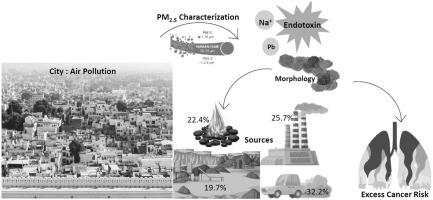Atmospheric Pollution Research ( IF 3.9 ) Pub Date : 2021-08-05 , DOI: 10.1016/j.apr.2021.101164 Parth Sarathi Mahapatra 1 , Upasana Panda 1, 2 , Chinmay Mallik 3 , R. Boopathy 1 , Sumeet Jain 4 , Sudhir Kumar Sharma 5 , T.K. Mandal 5 , Shantibhusan Senapati 4 , Priyadatta Satpathy 1, 2 , Subhasmita Panda 1, 2 , Trupti Das 1

|
Bhubaneswar is a rapidly developing city in the eastern coast of India. Previous studies are evidence of the importance of its location for understanding the outflow of pollutants from mainland India into the Bay of Bengal, specifically during the winter. Therefore, we present the characteristics of PM2.5 (particulate matter with aerodynamic diameter < 2.5 μm) collected during a land campaign between November 2014 and January 2015 (representing the winter). Gravimetric measurement of mean PM2.5 was in the range of 101–142 μg/m3 at different locations that was approximately 65–135% higher than the 24 h average National Ambient Air Quality Standards (NAAQS). Spectrometric measurement of PM2.5 and PM1.0 depicted a typical diurnal pattern with distinct morning and evening peaks, confirming similar source contribution and a higher accumulation mode PM over the traffic location. For example, 85.7, 79.1, 80.6, and 84.8 % of PM1.0 contributed to PM2.5 at reference, residential, industrial, and traffic sites, respectively. Chemical characterization and Positive Matrix Factorization (PMF) indicated four most probable sources of PM2.5 with major contributions from vehicular emissions (32.2 %), followed by industrial (25.8 %), combustion (coal, oil, and biomass burning at 22.4 %), and crustal sources (19.7 %). Enrichment factors and mass closure analysis supports this observation. Microstructural analysis broadly classified the PM2.5 particles into four categories. For the first time Endotoxin concentrations in ambient PM2.5 (0.021 ± 0.022 EU/m3) were quantified as a step ahead to understand the biological composition of PM. Heavy metals detected in PM2.5 were used to perform an excess cancer risk assessment.
中文翻译:

印度东部沿海城市土地运动研究期间冬季 PM2.5 的化学、微观结构和生物学特征
布巴内斯瓦尔是印度东海岸一个快速发展的城市。先前的研究证明了其位置对于了解污染物从印度大陆流入孟加拉湾的重要性,特别是在冬季。因此,我们展示了2014 年 11 月至 2015 年 1 月(代表冬季)的陆地活动期间收集的 PM 2.5(空气动力学直径 < 2.5 μm 的颗粒物)的特征。不同位置的平均 PM 2.5 的重量测量值在 101–142 μg/m 3的范围内,比 24 小时平均国家环境空气质量标准 (NAAQS) 高约 65–135%。PM 2.5和 PM 1.0 的光谱测量描绘了一个典型的昼夜模式,具有明显的早晚高峰,证实了交通位置上类似的源贡献和更高的积累模式 PM。例如,在参考、住宅、工业和交通场所,PM 1.0 的85.7、79.1、80.6 和 84.8% 分别导致 PM 2.5。化学表征和正矩阵分解 (PMF) 表明 PM 2.5 的四个最可能来源,主要来自车辆排放 (32.2 %),其次是工业 (25.8 %)、燃烧(煤、石油和生物质燃烧,占 22.4 %)、和地壳来源(19.7%)。富集因子和质量闭合分析支持这一观察结果。微观结构分析大致将 PM 2.5分类粒子分为四类。首次对环境 PM 2.5 (0.021 ± 0.022 EU/m 3 ) 中的内毒素浓度进行量化,作为了解 PM 生物成分的先行一步。PM 2.5中检测到的重金属被用于进行过度癌症风险评估。











































 京公网安备 11010802027423号
京公网安备 11010802027423号